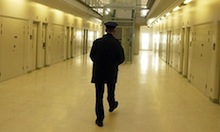
A prisoner at Maghaberry jail has said those who took part in an Easter protest at the jail continue to be kept in lockdown for 23 hours a day.
The Irish Freedom Committee, a US human rights-based organisation supporting the republican prisoners at Maghaberry, has called for an “immediate, impartial investigation” to be launched into the “numerous, and long-standing human rights complaints” by the republican prisoners and their families at Maghaberry jail.
It published a communication from a prisoner at Maghaberry, who wrote of the treatment of those who occupied a dining hall at the prison on Easter Sunday in protest at the conditions.
“After 36 hours upwards to 150 police and jailers surrounded the canteen with riot gear, shields, helmets, gas masks, balaclavas, axes, sledge hammers, picks and power saws and appeared ready to remove everyone by force. POWs were taken out one by one through lines of police and dogs,” he wrote.
“Each strip searched, 13 taken to isolation units and 15 were returned to empty cells. 13 were charged under Rule 7 by the Secretary of State for one and a half days. No one allowed a change of clothes for four days.
“All have been returned to Roe House [the republican wing] and are being held under Rule 35 and kept in lockdown for 23 hours a day. The cells of some of the 13 returned from isolation units were wrecked, towels in the toilet wet mattresses etc. each cell took hours to clean. All 28 have been charged with ‘mutiny’.
Relatives being told that they had not properly scheduled visits, PoWs being told that they had no visits when they were on the schedule. Meals are still an issue, not making it to the prisoners as scheduled etc. Situation worse now than before Easter.”
A letter writing campaign is underway to encourage the involvement of Amnesty International, as well as directly urging the British government to address the situation at the prison.
THREAT
Meanwhile, reports have claimed the PSNI police believes the threat from the breakaway IRA groups is the highest in ten years.
it is reported that the groups known as the Real IRA and Oglaigh na hEireann are increasing in number and growing confidence.
The ‘threat level’ has been assessed by the PSNI as severe since February 2009, one notch below ‘critical’.
A ranking PSNI member told British UTV television: “There is an element of skills which would have been available to the Provisional IRA, which are still obviously apparent in the construction of some of these devices.
“The situation has got worse since the threat was raised to ‘severe’. This is probably as severe a situation as we’ve seen since that Real IRA bombing campaign of 1997 going into 1998.... It feels to us, just looking at it in every way, that this has picked up in terms of intensity and severity.”
A specialist British army unit took part in a raid on a flat in the Creggan area of Derry last week.
The raid took place on Wednesday at a flat in High Park where a member of the 32 County Sovereignty Movement (32CSM) was staying.
It is believed to be the first time that British military personnel have been involved in a house search in Derry in recent years.
The search on the flat lasted for several hours and those involved wore white overalls and face masks.
A document given to the 32 CSM member by the PSNI during the search lists who was present during the search operation and includes the names of three British soldiers, a sergeant, lance corporal, and a sapper, who are described as being members of a “military search troop”, based at Aldergrove.
The document also lists PSNI members and crime scene investigators and an individual described with the unknown acronym, “MCFA”.
The 32CSM in Derry said they had previously suspected that undercover British army units were operating in republican areas. A spokesperson for the group said; “This confirms what republicans knew already; that the British army are involved in undercover operations in Derry. We now have documented proof of that.
“Here we have British soldiers harassing people and raiding houses in Creggan, just as they did in the 70s, 80s, and 90s.”
![[Irish Republican News]](https://republican-news.org/graphics/title_gifs/rn.gif)
![[Irish Republican News]](https://republican-news.org/graphics/title_gifs/harp.gif)

